Estimated reading time: 29 minutes.
July/2015 - To say that Sony is an innovative company is an understatement. The “Asian Apple”, it never shied away from “disruptive technologies”: an innovation that helps create a new market and value network, and eventually disrupts an existing market (wikipedia). The first Walkman, Playstation’s 3D graphics, VAIO’s laptop designs… Anytime a consumer product gathers attention due to its design and innovation, there’s a great chance you’ll find the “Sony” logo in front of it.

vlog do zack’s Sony kit: A7II, FE 55mm f/1.8 ZA, FE 28mm f/2 and RX1R. Which’s going to make the cut?
Sony also started a silent revolution on the domestic photo market. Owner of the Cyber-shot brand, it all began with the Mavica line in 1987, a “still frame camera” that used a camcorder CCD to record video grabs. Who can forget the floppy Mavicas, a millennial sensation? In 2006 all this innovation left the prosumer market with the acquisition of Konica-Minolta, inheriting some decades worth of optical technology, including the A-mount still used on Sony’s SLTs.
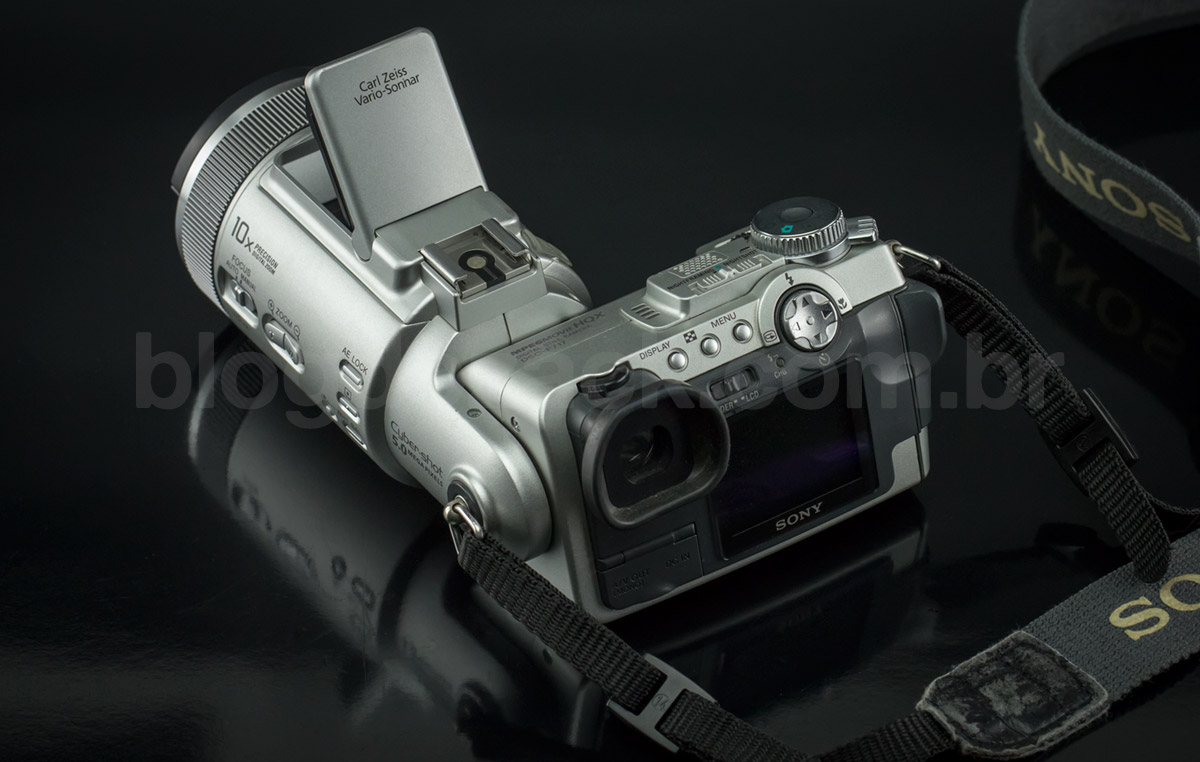
The Sony F717, vlog do zack’s first “serious” digital camera: f/2.2 lens, all manual exposure and laser assisted focusing!
The Sony Alpha 7 is a result of such history. Practically with no peers on the market, it’s so ahead of its time that it will barely be appreciated by most photographers. Landing on a “have it all, all the time” period, it’s simply everything that can be put inside a consumer electronic, almost a prototype, but in the form of a digital camera, fully functional and with a relatively cheap price tag. It’s the world’s first full frame mirrorless ILC (interchangeable lens camera), EVF (electronic viewfinder, different from Leica’s range finder), and a new category of equipment.

The A7II is the second generation of a three model lineup: A7 with 24MP full frame CMOS and speedy hybrid phase+contrast AF; A7R with 36MP for precision photography (studio and landscape); and A7S, with larger than life photodiodes and high sensitivity. With A7II and A7RII already on the market, their biggest headline is the built-in SteadyShot Inside, promising up to 4.5 stops of compensation. Does it work? Is it the camera we’d been waiting for? Nice reading!

First what calls our attention is the A7II size. Small for a full frame 135 format + interchangeable lenses, but huge for the mirrorless market, dominated by the tiny Micro Four Thirds, the A7 sits right in the middle. At 12x9x6cm and 556g it’s 30% smaller than an EOS 6D DSLR at 14x11x7cm and 770g; but twice the size of a Panasonic GF7 at 10x6x3cm at 342g. Sony is indeed creating a new form factor, as small as possible with a large sensor and full frame lenses.

Still the A7II grew 1cm compared to the previous A7, and features a fresh designed frontal grip. On your hands it doesn’t sit comfortably because the main support goes the right hand thumb, at the back of the camera body, and not to the four fingers at the front like a big SLR. You have to “balance” the A7 with your thumb, not hug it like a DSLR. It’s very uncomfortable with sharp corners and a nightmare if you have large hands. It’s not very thoughtful with photographers but more “style” oriented, and it’s a bad thing. They should’ve done a mirrorless A99!

On the hands the A7II is balanced on your thumb, at the back, and there isn’t much to grab at the front.
At the front the size difference is clearer: the full frame E-mount is enormous at the center and there’s practically no hand grip. Centered to the mount is the EVF bump, and to the left there’s the lens release button, near the ring finger. To mount/unmount you must balance the camera with your thumb at the back and press the release with the ring finger at the front. It’s smaller that I wanted it to and I question it’s durability. It feels very plasticy and a bit tight, not as smooth as Canon’s EF or MFT camera. We’ll find out if it still works on a few years time.

The E-mount was born on the NEX system, accepts APS-C and full frame lenses. It’s very big for a mirrorless camera.
Inside the E-mount lives the A7 soul: a full frame CMOS sensor and no mirrors. For newbies, “SLR” means “single lens reflex” and the camera uses a mirror to “reflex” the lens image on prism viewfinder, or “optical view finder” (OVF). On modern “mirrorless” systems, the camera acts like a videocamera and streams the full frame image on a tiny electronic view finder (EVF), that allows new usages like exposure preview, many data overlays and real color preview. Is it the future?

The path: D800E and EOS 6D DSLRs uses a mirror and a prism. The mirrorless GF3 and A7II uses magic!
Inside is also another headline of the second generation A7 lineup: the SteadyShot Inside. The imager is mounted on a moving platform that compensates for camera shake. It’s so big and powerful the camera vibrates like a video game rumble pack when you turn it on. The in-camera stabiliser works with any lens, be it via adapter (you can set the focal length on the MENU) or even Sony’s OSS for up to 4.5 stops of correction.

And it’s phenomenal! With the Sony FE 55mm f/1.8 ZA, one can easily reduce three, four stops of the shutter speed with a bright, large aperture lens. It’s a completely new way of shoot on full frame: low noise + large aperture + slow shutter speed, for better low light photos. Or even creative effects without a tripod, or smoother handheld videos. It’s the first A7II disruptive technology: the SteadyShot essentially let’s you shoot different photos on full frame, with any lens.

“Carousel” with the A7II + FE 28mm f/2 at f/14 1/3 ISO100; a creative long exposure, without tripod.

100% crop, the SteadyShot held everything in place.
At the top the panel is functional but far from perfect. It’s all there: the standard hot shoe with Mi interface, the PASM wheel, an exposure compensation dial, two custom buttons C1 and C2. It feels the same as the smaller RX line and another missed opportunity. There’s. No. Top. LCD! There’s no quick way to see the battery, card and EV status, and it takes forever for the camera to boot. Sony should’ve taken some Canon T6s clues: put the PASM dial to the left and a tiny LCD to the right, with C buttons at the front. There’s plenty of room for that, as the left side feels neglected.

At the back there are two screens that make another big difference in usability: when you turn the camera ON, either the LCD or the EVF are active and using precious battery power at all times. Usually on a DSLR you can leave the camera “ON” and nothing happens: the top LCD shows some data, the camera is ready, but using minimum power. Take it in your hands, half press the shutter release, shoot. Not on the A7 series. If it’s ON, it’s using all the power possible, the OLED EVF hogs about 15% more power than the larger back LCD, the SteadyShot is ready and depending on how you set the camera, both focus and aperture are working! So it’s a good idea to leave it off.

But when you turn it ON/OFF so many times, it’s clear how the A7II booting time lags behind any “always ON” DSLR. And I lost photos because of it. I turned the rocker, ~waited for the camera to boot~ (about 1.5 seconds) and until it locked focus, stabilised and shot the picture, three, four seconds went from the perfect framing. It’s unthinkable for street photographers. I’m not asking for the 300mm boot time of a EOS T3. But at least the 0.47s of a Panasonic GF6, that is also mirrorless. Imagine a long afternoon in the studio how many battery packs you’ll need?
The rear 3” LCD tilts up and down, and fits 1.23k pixels with WhiteMagic (3RGB + 1 white for higher brightness). It’s just like Nikon’s D750: fragile, will bend at the first impact, and it’s probably not splash proof like a proper “pro” SLR. And it’s definitely not dust sealed, as my camera already shows some dust spots inside. AND it’s not touch screen neither, like the 2012 Canon T4i. I laughed when I used that camera but I miss how easy it was to simply touch the screen and set focus. Considering Sony’s chaotic MENUs, I REALLY MISS a touch screen.

The panel is very thin and fragile. Will easily break as soon as you’re careless…
Inside the EVF lives a 2.3k OLED screen with 100% frame coverage 0.71x magnification, with the same data as the rear LCD. Unfortunately it won’t tilt out of the frame like a camcorder, another missed opportunity. But it works well: there’s no lag between the subject and video feed, and the extra information can be useful at times. It’s not the same as an OVF: the video rendering shows some aliasing and the colors are way off, and you can see the pixels. Not perfect but nice to use.

The overlays are very complete, be it on the LCD or EVF: shooting and playback modes straight in your eyes!
The auto-sensing EVF is also too sensitive. Every time I tried using the LCD pointed up and the camera at waist level, it detected my belly (which is not that big, by the way) and turned the LCD off. And that’s about 15cm from my body. Or in the studio when I used the LCD pointing down and the camera near a soft box on top of the table. Again, the EVF sensor detected the box as an obstacle and shut the rear screen off. It’s too sensitive and you can’t adjust it. You can select only between LCD/OLED (not auto-sensing), hidden under 20 MENU tabs.
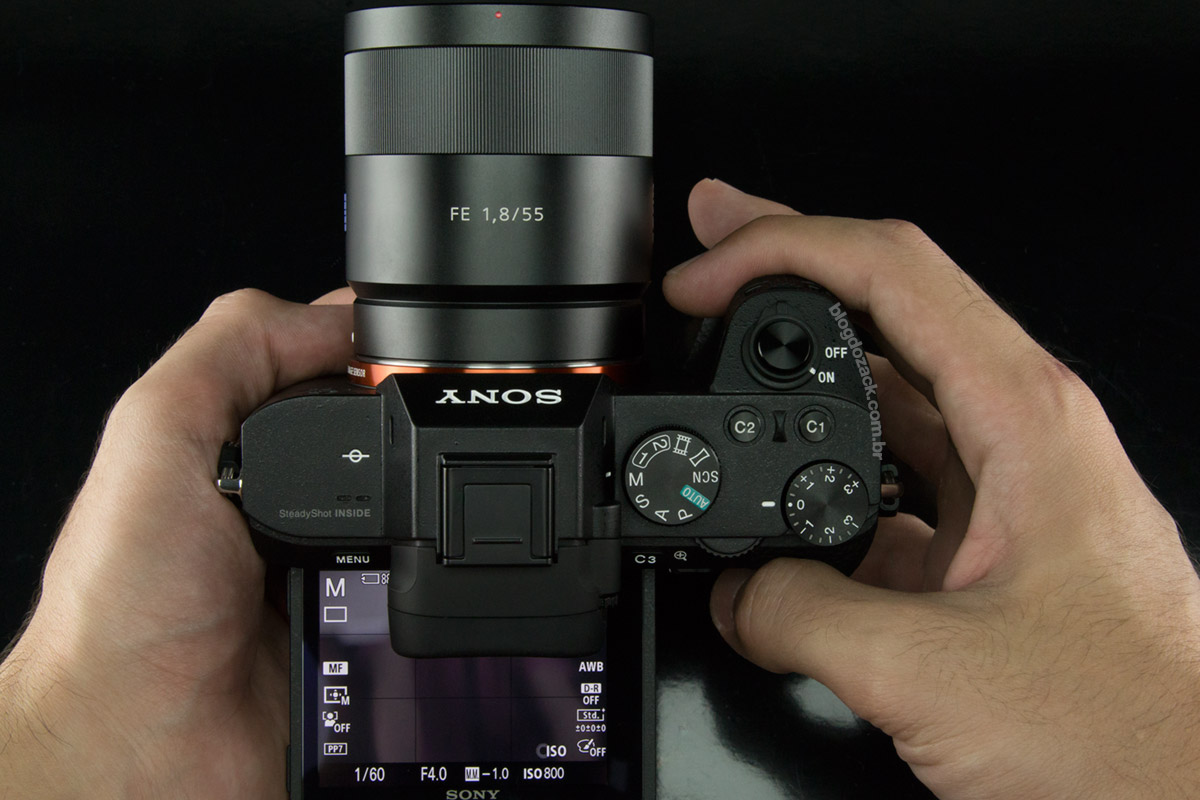
Looking over the camera, the EVF sensor often shuts the LCD screen. I worked here because I was far from the camera, behind the tripod.
Besides its power consumption, I actually liked having both screens on at all times, coming from a DSLR. Some shots are better framed this way, like architecture and some creative angles. And every DSLR Live View on/off cycle is slow. So here’s an idea for Canon and Nikon: how about adding a proximity sensor to the camera and programming an “auto” Live View mode, that would work when you put the camera away from your eyes. It’s a paradox as I complained about power consumption, but sometimes it’s very useful like on these shots:

“Yoga” with the A7II + FE 28mm f/2 at f/2 1/1600 ISO100; waist level framing, with Live View and tilted LCD.
At the back there’s the standard Sony button layout, be it on recent RX Cyber-shots or Alphas. A mini-dial (“Control Wheel”) with four directional clicks and a horrible tactile feedback, way too smooth. There’s a Fn and center button inside the AF/MF switch, for AF or AEL. At the top there’s a custom C3 button on the right, and a lost, MENU button on the left. The playback and trash can (also custom C4) are lower on the panel. And the second horizontal JOG dial, that sets the aperture/shutter is near (but not quite on) the thumb rest. Last but not least (or not) is the REC button, completely hidden away any conceivable logic behind the thumb grip.

The rear controls are all right balanced. So there’s no way to use the camera with a single hand, as the thumb must be on the grip to balance the body.

“Control Wheel” jog (left) has four click directions, plus a central click. And the AF/MF-AEL switch has another central click button.

C3 button on the right, MENU on the left. Who designed this left side?

PASM dial is easy to turn, with excellent feedback. It feels metal and won’t break easily.
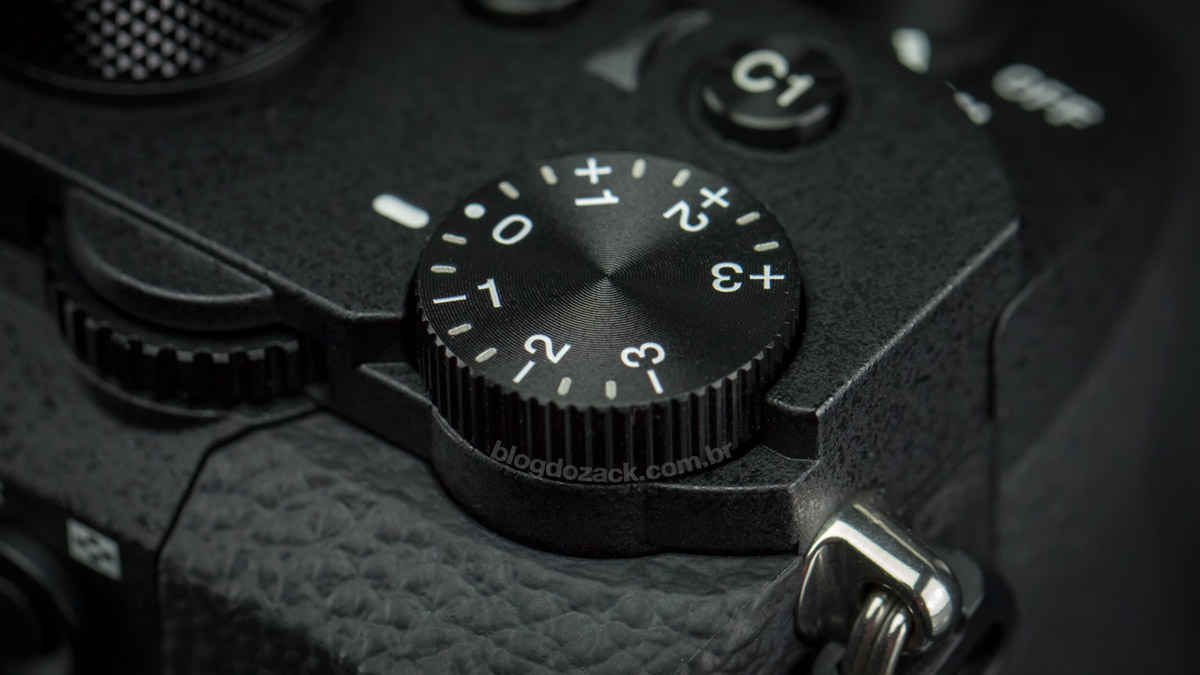
The +-3EV compensation dial works as greatly as on the RX1.
I won’t explain each button because the A7II is very customisable. There’s a unique Custom Key Setting menu tab just for the buttons, although it lacks important settings. For instance, the top horizontal rear jog is a piece of shit. I’m not a fan of swearing, but congrats to Sony on the shitty top rear dial. Again. On the original A7 it was too easy to turn, now it’s too hard. There’s a tab (?) on top of it and it’s too far recessed into the body, nowhere near the tip of your thumb. Not a problem as it probably won’t be used much: just to set the aperture or the shutter values!

The shutter/aperture can only be switch between both front and rear horizontal dials, not the Control Wheel.
As both dials are shitty, I tried programming the aperture to the rear vertical dial like Canon does. But it won’t. You can set the “Control Wheel” to ISO, White Balance, Creative Style, Picture Effect… But not aperture! Under Custom Buttons you can even set “Download Application” as a shortcut, but can’t get rid of the exposure setting from the shitty horizontal dials. And it’s ok, you can easily see these value on the top LCD… Not. It’s a deal breaker if you’re coming from a DSLR.
Another chronic Sony issue are the gazillion-non-sense MENU tabs. There’s no logic whatsoever. None at all. It’s six main tabs, but under the first one (camera icon) there are NINE submenus. Some make sense: image quality, video format, focus area, ISO… No, wait, ISO? Yes! ISO is hidden on the forth menu. On the sixth menu the “Center Lock-on AF” (works like 3D tracking) is together with “Soft Skin Effect” and “Long Exposure NR”. Sure, makes sense! Those selfie-taker, Harajuku girls need the Soft Skin fx to use together with the Center Lock-on AF. Got it? Brilliant!
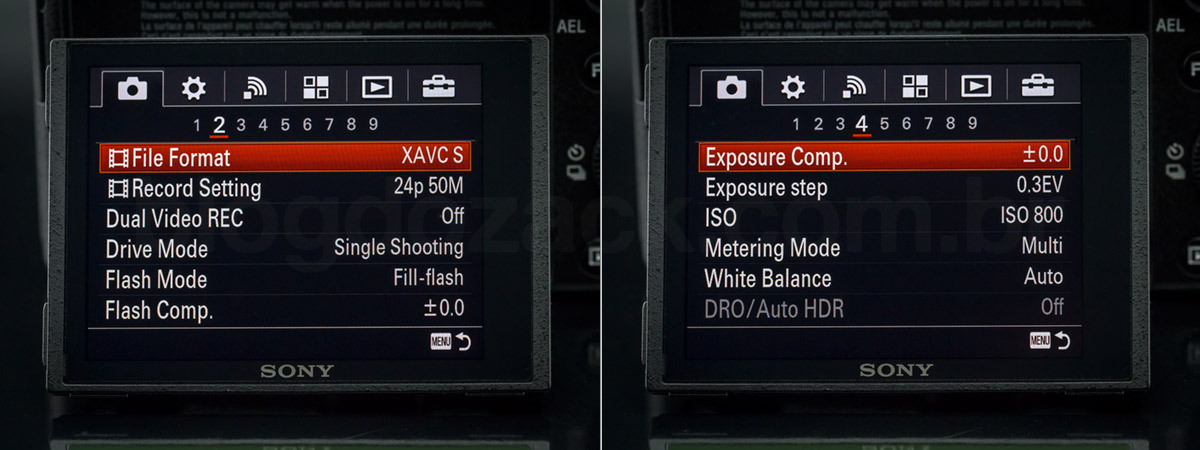
Flash mode together with video mode… Hidden ISO under the fourth menu…
Still under “camera” there’s “SteadyShot” on the same page as ~Color Space~; really? Fourth menu: FINDER/MOTION (IN CAPS LOCK), together with “AF w/ shutter” (adjust the shutter release behaviour). Submenu 5: Exp.comp.set on the same screen as “AF Micro Adj.”. Submenu 6: Lens Comp., that controls how the BIONZ X fixes lenses problems, on a menu mainly about buttons.

Flash mode together with video format… ISO hidden under camera…
Sad but true. And it’s not two, three functions that you’ll remember where they are. It’s six tabs with 9, 7, 2, 1, 2 and 6 submenus on a camera that’s complex to begin with. I probably run through these menus over 50 times just to set the LCD/OLED sensor on and off. During my week with this camera around the streets of New York, I literally had to stop, move myself away from the sidewalk and circle through all 21 menus to set something stupid. I’m convinced Sony does that on purpose because these menus are bad since the first NEX C3 Alpha I used in 2011.

Every single submenu on the Sony A7II. No logic whatsoever. SHAME ON YOU, SONY!
Under the door to the left there’s USB and HDMI, plus MIC and headphone. The USB port is used to charge the camera and download photos, like a smartphone or Cyber-shot RX. The US$1700 camera doesn’t come with a charger. I kind of like it: anywhere with an USB plug and you can charge your camera, like on a plane seat or car dashboard; or even a external battery pack. But you can’t charge while you’re using it (the new A7RII can), so you’re dead in the water when the battery is empty. Prepare to purchase an external battery charger from Sony.

The battery goes underneath the camera and doesn’t last long enough for you to circle around the menus all day. It’s a NP-FW50 (W TYPE) with 1020mAh. The RX1 uses a NP-BX1 (X TYPE) that’s 50% smaller but fits 1240mAh of power! Ok, the W TYPE supplies 7.4V whilst the X TYPE is 3.6V, but that the hell? To manage this camera is like a bad iDevice: charger it overnight, use it during the day, and pray for the battery to last as long as possible. It’s very different from a CanoNikon DSLRs that can last days on a single charge. Sony must address this on the next generation.

The NP-FW50 is too small for so many menus…

No Sony wall charger. A US$1700 that comes with no charger, LAME!
Last but not least the SDXC card goes on the right and sits behind the worst card door of all times. It’s right where your hands sits around the camera, and it grips with your palm. So at any front > back movement, it opens! It’s too flimsy and grippy, and will open at minimum contact. It’s unbelievable. Devil is in the details and these little things will flip you out around the streets. Think carefully before switching from Canon or Nikon, please.

The SDCX door card opens way too easily, any light touch and it is open…
Overall the A7II tries to be a serious mirrorless camera like the Panasonic GH series on the Micro Four Thirds format. They designed a modern piece of equipment that is functional, it works like a camera. But it’s a camera from the future when the human hand shrunk and we have plenty of brain power to remember all 21 submenus. It’s an post-apocalyptic future that Sony sees to us, and I’m not sure I want to be in it. I rather stay tied to tradition with Canon and Nikon.

With 117 phase detection points and 25 contrast detection zones, the “regular” A7 (nor R nor S) is the option for speed. It makes sense: 24MP + hybrid AF + 5fps is more than enough for most shooters. And I must say it’s the best A7II feature so far: the AF is as quick as the worst DSLRs. At least with Sony FE lenses, like the 55mm f/1.8 ZA and 28mm f/2 that we’ll see in the future, it locks focus in less than a second, fast enough if you work with good technique. Sony is on the right track.

“Thunderbolt” with the A7II + FE 28mm f/2 at f/8 1/400 ISO100; 5fps is more than enough for everyday situations.
The A7II is a world of difference to the RX1R. While that camera has it’s own place on the market (and my kit) as the only really portable full frame camera, I didn’t make clear in my review how awful the AF was. It’s slow, hunts all the time and fails to lock. Around the streets at night, forget about it. And I was fearing this would happen on the A7II. It didn’t. Yes, the phase detection points are too crowded around the center. But it sets the contrast detection on the right direction and it all happens quickly: press the button, it’s locked!

Inside these [ ] are the 117 phase detection points on the A7II; too close together to be flexible.
It works on four modes: AF-Single, AF-Continuos, DMF (direct manual focus) and MF. Around five areas: Wide, Zone, Center, Flexible Spot (small, medium or large) and Lock-on AF (almost a Nikon 3D tracking). The AF-S is standard: point the camera, half press the button, it locks is place. The AF-C is different: point the camera, half press the button, and it won’t lock, it will continually adjust itself. And the Lock-on AF follows your subject from the center of the frame. It’s like Nikon’s 3D tracking and you can see it following your subject, changing the phase points or contrast zone accordingly. But sometimes it has a life of its own: it jumps around and looses itself.
But in general the AF is quick with Sony lenses. I have no doubt I wouldn’t miss a photo if the camera was already on because of AF performance. It is that fast: point, focus and shoot. But again it’s far from any DSLR. As soon as I started working back with my EOS 6D + EF 70-200mm f/2.8L IS II USM I was reminded how fast the Canon EOSs really are. There’s no comparison between the two and a warning if your life depends on AF performance: the Sony is good, but not as good as the Canon (or Nikon) systems, no matter what you read online.
On the other hand the manual focus features the best an EVF can do: peaking. It’s a colour highlight around contrast edges that makes manually focusing a breeze. It’s much more precise than nowadays DSLR eye guess (no split prism), but not as precise as Leica’s range finders. It works anytime during DMF (direct manual focus), zooming as soon as you turn the lens ring. It’s impossible to miss focus like this although it’s not very fast. It works well.

The peaking on red color (you can set to yellow and white), showing the high frequency contrast area.
It’s very handy if you plan on using the A7 with a lens adapter. metabones produces an all electronic EF/EF-S to E-mount adapter, with aperture control and AF. But it’s so slow you’re better served by the manual focus with peaking mode. And sometimes it doesn’t really work: together with the Yongnuo 50mm f/1.8 EF, the A7II refused to lock focus. So that’s the importance of an easy to use manual focus and one of the advantages of the EVF. Both vlog do zack’s Canon EF 50mm f/1.8 STM and Yongnuo 50mm f/1.8 EF reviews were shot with the A7II + metabones in manual focus, and I had no problems using it.

Another headline of the A7 line is the perfect convergence of photo and video. Canon led the enthusiast “HDSLR” market when it introduced the 5D Mark II in 2008, but it stood still with lots of aliasing and moiré. But on the A7II the video quality is near excellent: a very clean 1080p stream, with a bit more resolution than most Canons EOS (except Cinema models), and with very advanced functions. The XAVC S H.264 codec goes up to 50Mbits; it can record at 60FPS. And the S-Log2 Picture Profile was added from the CineAlta professional Sony cameras. If you’re working with video on a DSLR, don’t think twice: the second generation A7 (II and RII) were made for you.
You can feel the different look on every file. Even at 28Mbit in AVCHD the image looks solid, with more details. It’s closer to the FS100 than the ageing EOS 5D Mark III, and you know how much each costs. The noise is organic and the gradient rollouts are smooth, with almost no banding.

100% crop, notice how the noise and gradients are organic.

100% crop, some macro blocking is visible, but much less noticeable in motion.
Motion is not as organic as some Blackmagic cameras, and looks a lot like video, not film. The BM Cinema Camera register a much longer streak of blur on high paced motion for a more cinematic feel. The A7II at 1080P60 looks too sharp, but works when conformed to slow motion. Both cameras can’t be compared: different format, size, maximum resolution, FPS, workflow… I won’t switch from the Cinema Camera to the A7II on vlog do zack.
The A7II pixel binning is not perfect and some moiré + aliasing remains visible. If you’re shooting interviews with longer focal lengths and shorter depths of field, it will probably be invisible. But on wider angle panoramic shots, with lots of details, and you might wish for a better camera. It’s a huge step ahead most Canon DSLR (except the EOS 1D-C), but lagging behind a Blackmagic or even a Nikon D750 that uses a newer Sony sensor. vlog do zack’s was born on the 5D II boom, so any improvement is much appreciated.

100% crop, some moiré on repetitive lines, the BIONZ X is still not finely tuned for the A7II sensor.
The 50Mbits XAVC S has so much data in it that you must use a SDXC card to activate it on the menu. And it makes a world of difference on some situations. For example using the S-Log2 hidden in the Picture Profile 7, the native ISO1600 is automatically set and you need all this data to perfectly record the noise. The AVCHD will blur some of the noise away, so it’s a good idea to keep some SDXC cards on your kit. The S-Log2 is Sony flat log profile made to record all 14 stops of dynamic range on Exmor sensors, surpassing the Rec-709 gamma, and must be post graded.
These Picture Profile are the most sophisticated video features I’ve ever used on a compact camera. Absolutely everything can be adjusted between the Exmor sensor and the BIONZ X processor. There are nine gamma settings from standard, Cine1 (HG4609G33 curve), Cine2 (HG4600G30 curve), ITU709 and S-Log2. Black Gamma and knee points, color modes including “Pro” (to match Sony’s professional broadcast cameras) and S-Gamut.

Not to mention the SteadyShot that makes any lens as smooth as a steadycam, without the jitter on most CanoNikon handheld captures. I get mad when I see those shaky wedding reception videos. It won’t happen with a A7II and by itself is another selling point for video shooters. The camera body is smaller, lighter and healthier on your back after a full day of work. You can even shoot it eye level with the EVF, it’s genius!
My only complain about shooting video with the A7 and most Sony cameras is how they organize the files. They’re not on the same folder as the pictures nor a video specific folder. It’s hidden under three directories: “private” > “M4ROOT > “CLIP”. It’s how Sony wants you to burn it on Blu-rays, because that’s exactly how the world is watching videos today. Not. They need to fix it because sometimes de XAVC S and AVCHD files are not even on the same folder. God, why?!

Seriously, Sony? I mean, REALLY SERIOUSLY AWFULLY, SONY???
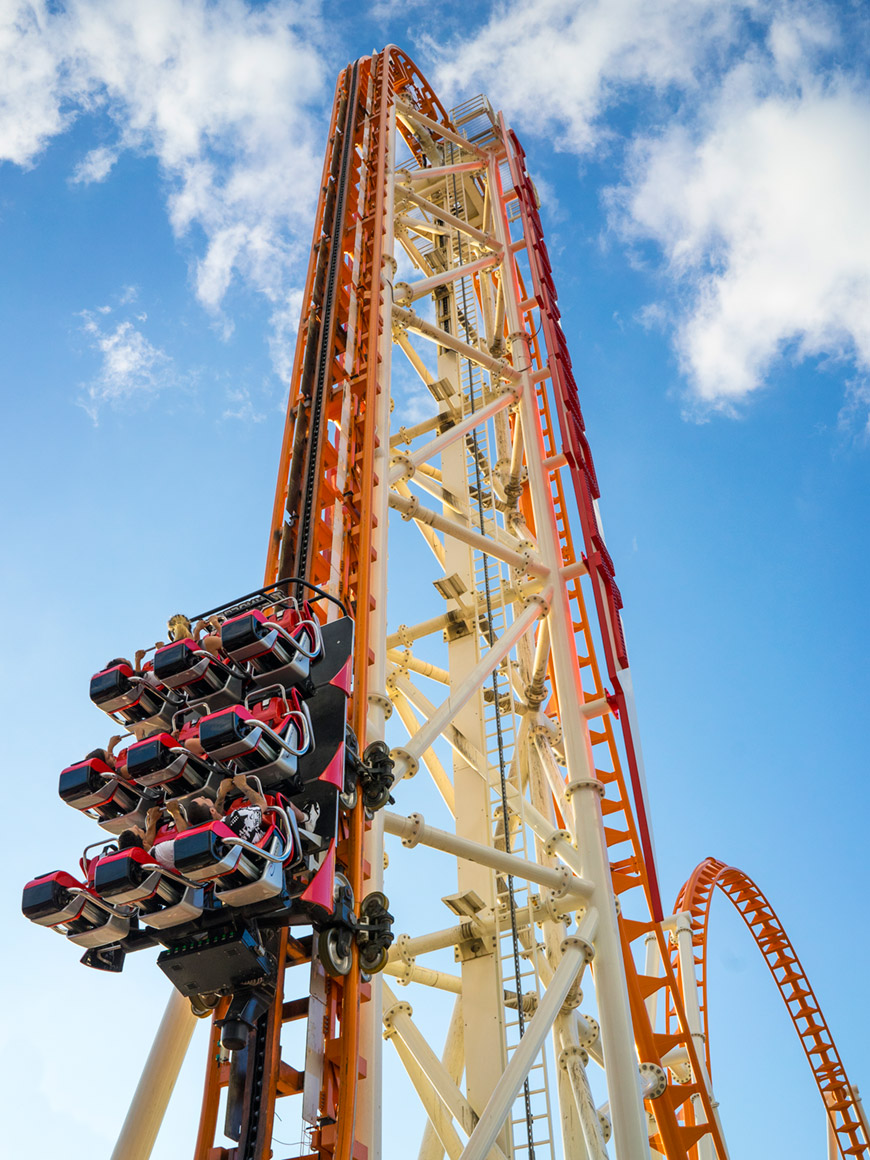
“Thunderbolt” with the A7II + FE 28mm f/2 at f/8 1/1000 ISO400.
Sony has been kicking ass with semi conductor technology, delivering the highest performance image sensors the market has ever seen. They manufacture every full frame sensor used by Nikon (with exclusive designs), every iPhone 4, 5 and 6 sensors; even the 1” Canon G7X sensor is suspected to be from Sony. They’re called Exmor and feature structural differences against the rest of the market: from the micro lenses arrangement to the silicon wafer height, even the material used like the new copper made Exmor R on the 42MP back-illuminated A7RII.
On real life the main consequence is the camera “dynamic range”, in other words, how many stops of light the sensor can record from the brightest to the darkest. While our eyes can almost infinitely see different brightness levels on a single scene, the analog sensor in our cameras either blow the highlights when there’s too much light, or completely turn the shadows to black. Sony is ahead of the game: with a declared 14 stops of dynamic range, you can easily manipulate the raw Exmor files to recover what your eyes saw in real life.
You can push the exposure up to four, five stops from the original shot with practically no loss in quality. Canon does something similar: you can recover shadows and lights as well. But two, tree stops maximum. Anything above it and the sensor “clips”. Not to mention the problems with banding, noise and magenta color casts. Not on Sony’s Exmor. Some complicated light situation don’t even require a fill-in flash! You can shoot the model under some shadow and light the file back up in post. Landscapes are much more dramatic: you can compensate for the light loss in a whole forest whilst exposing the sunset. Amazing!
The ISO performance is a bit dated on this “basic” 24MP Exmor, and it shows more noise at ISO1600 than the competition. Compared to other Exmor sensors [36MP (A7R), 12MP (A7S), 42MP (A7RII)] or even some Canon full frames, the grain in much more apparent on the A7II. It’s exactly one stop behind the EOS 6D, the Canon at ISO6400 looks like the A7II at ISO3200. It’s not bad as the noise is quite organic and beautiful, surely invisible on paper. But we can’t deny: it’s an old imager.

“Test table” with the A7II + FE 55mm f/1.8 ZA; the EOS 6D will be fitted with the EF 50mm f/1.2L USM.
But we have a paradox and another disruptive technology here. If up to ISO800 the 24MP A7II Exmor can handle perfect software amplification, and looses performance via hardware at ISO1600, why not shoot at ISO800 and raise the exposure level on the computer? It’s a new idea for the digital era, at least with such high quality, similar to what we used to do on film. If the scene is dark, shoot up to ISO800 and light it up in post.

Left: EOS 6D ISO6400 1/500. Right: A7II ISO800 1/500 +3EV via ACR. On software the A7II looks cleaner, with less noise!
The A7II at ISO800+3 stops in Adobe’s Camera Raw is as clear as the EOS 6D at native ISO6400, with no loss in details or color cast. It’s very useful when you want to stop the aperture down to enhance depth of field or to use the lens optimised aperture (like f/8), without lowering the shutter speed to compensate. Nightly landscapes are sharper and with great colours, exposing the frame at ISO800 and amplifying the EV via software.

“Times Square” with the A7II + EF 50mm f/1.8 STM at f/5.6 1/200 ISO640; a night scene “lit” in post.
The colours are also great on the A7II and close to Canon’s on skin tones, in favour of reds and oranges. Actually it’s a bit too orange, while Canon balances pink/yellow/red/yellow better, made for asian models and culture. Portraits feel alive, hot, not yellowish like Nikon or brownish like Sigma. Greens are a bit neón, and need some fixing. But blues are deep and don’t mix with the red channel, for beautiful skies.

“WSHG park” with the A7II + FE 55m f/1.8 ZA at f/8 1/60 ISO100; but grass do look a bit neón, too electronic.
On a negative note is the moiré, much more apparent on the A7II than any other digital camera I’ve ever used. This 24MP Exmor with a low pass filter renders incredibly sharp files, almost like a AA-less camera such as the RX1R. But on the software conversion via ACR I had more moiré cases within a week using this camera than ten years processing Canon and Nikon files. Something to keep in mind for fashion and street photography.

100% crop, some chaotic moiré cases from a camera that uses a low pass filter, beware. O_o
And finally the BIONZ X JPEG engine is as “solid” as the videos in XAVC S. When I say “solid”, I mean clear color blocks, with zero noise, aliasing or pixels, rendering a very electronic file. Canon’s DIGIC processors maintain a much more pleasing “texture” at base ISOs. Not Sony’s BIONZ X. There are definitely more details on the image, but it looks like a video grab at times.
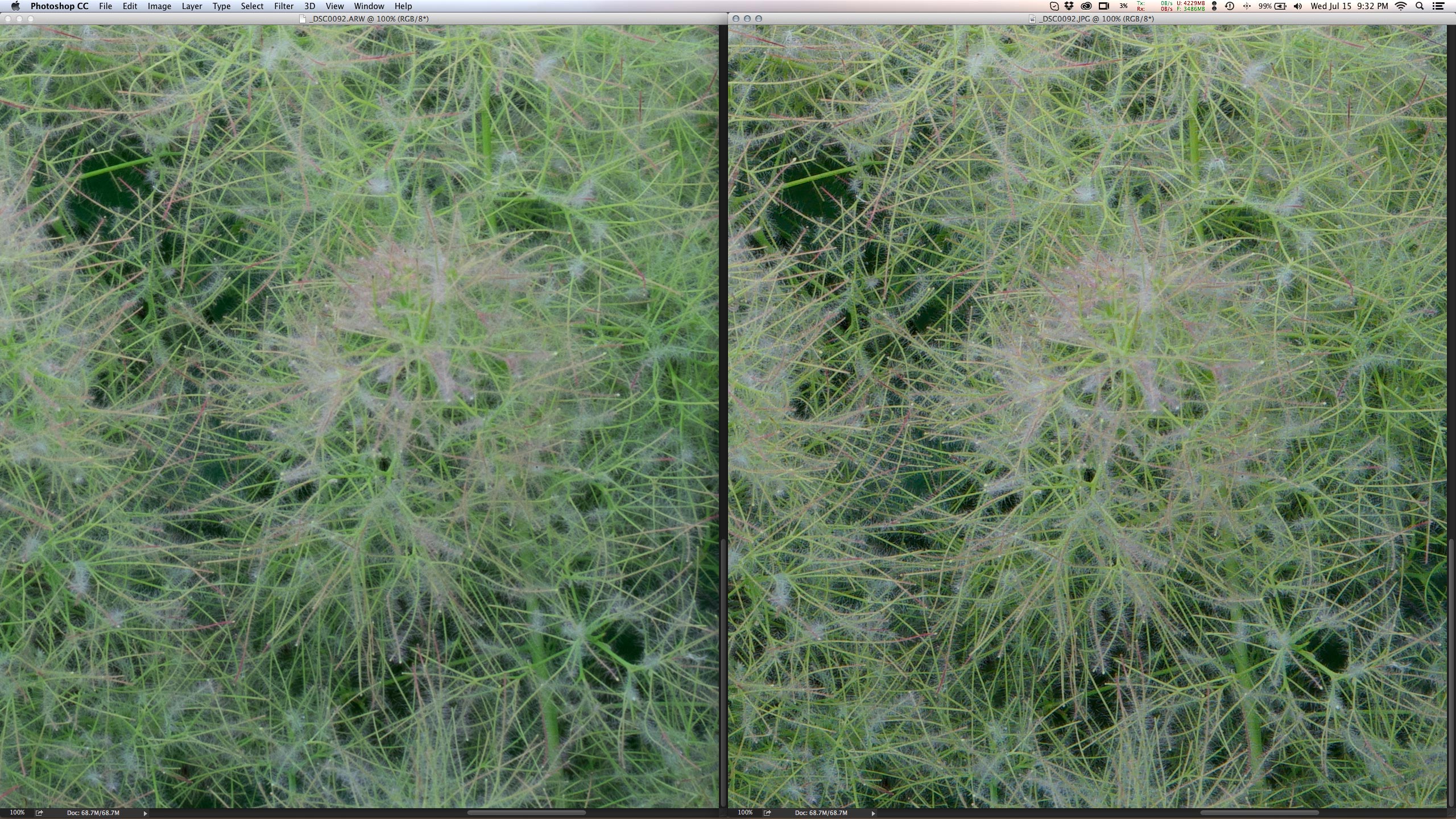
The BIONZ X JPEG (right) render sharper details on the default A7II setting, more than Adobe’s Camera Raw (left).
In high ISOs the processing is too aggressive trying to keep the noise down, combining pixels for, again, a solid block. It’s better to shoot raw and post process above ISO800:

It’s extremely aggressive with the noise above ISO800 (ISO10000 in this case), so you’re better of shooting raw (left).
Sony has been capping the Alpha and Cyber-shot RX lines to a 14bit compressed raw file. Apparently when you open these files on Adobe’s software, only 11bits of data are available whilst the real 14bit are rendered only by Sony’s own software. I support the idea that Sony indeed cap its camera by contract, as they supply some very similar Exmor sensors to Nikon FX DSLRs. RX1, A7 and A7II use a similar sensor to the D600/D610; the A7R uses a similar sensor to the D800/D810; and they all got this limitation. But miraculously the new BSI 42MP A7RII won’t have any raw limits.
If it makes that much of a difference for the volume of trolling around the internet? No, it doesn’t. In practically no file on mine I saw “posterisation” when I pushed the ACR slides side to side. That website that extensively “proves” this is an issue takes the files to an extreme nobody really needs to be. And I even question if Sony’s files are indeed compressed. The 20MP Canon EOS 6D generates 20MB files at ISO100, and the 24MP A7II generates 24MB files. So…

Sony files are not much smaller than Canon EOS 6D, and grow over the ISO level.
To end this article I would like to talk about the experience with a full frame mirrorless camera on my mostly SLR kit, and if the A7II will change something in it. The fact is Canon is apparently stopped in time on the video market and sensor technology, delivering the goods solely for the upper market with a US$16.000 C300II or US$30.000 ME20F-SH (that one with ISO4.000.000). There’s just too many angry voices online that know nothing about ergonomics, colours and usability over “dynamic range”, “4K” and the whole “mimimirroless”.

“Next generation of DSLR”. #not
Around the streets the A7II works wonderfully with Sony branded FE lenses. It’s smaller than most DSLRs, its AF is quick, and the files are technically superior if you know what you’re doing. But it’s as disruptive as the 80’s film compacts: small for sure, but not suited for most professionals. With such a small size, it’s a nightmare for people with large hands that need a big SLR to grip.

The kit I tested: A7II + FE 55mm f/1.8 ZA + FE 28mm f/2; it works!
In your hands the EOS 6D is big because it has to be, not because it has a mirror. It’s big to be comfortable while the A7 thinks about style before the photographer. A 6D + 50mm f/1.2L fits perfectly in most hands whilst the A7II + 55mm f/1.8 ZA is uncomfortable, too edgy, sharp, with less area to grip. With my large hands it’s impossible to hold the A7II safely, and it’s a fatal ergonomics mistake. And don’t blame it on the mirrorless thing: the Panasonic GH4 MFT is much better in your hands, with a much smaller sensor.
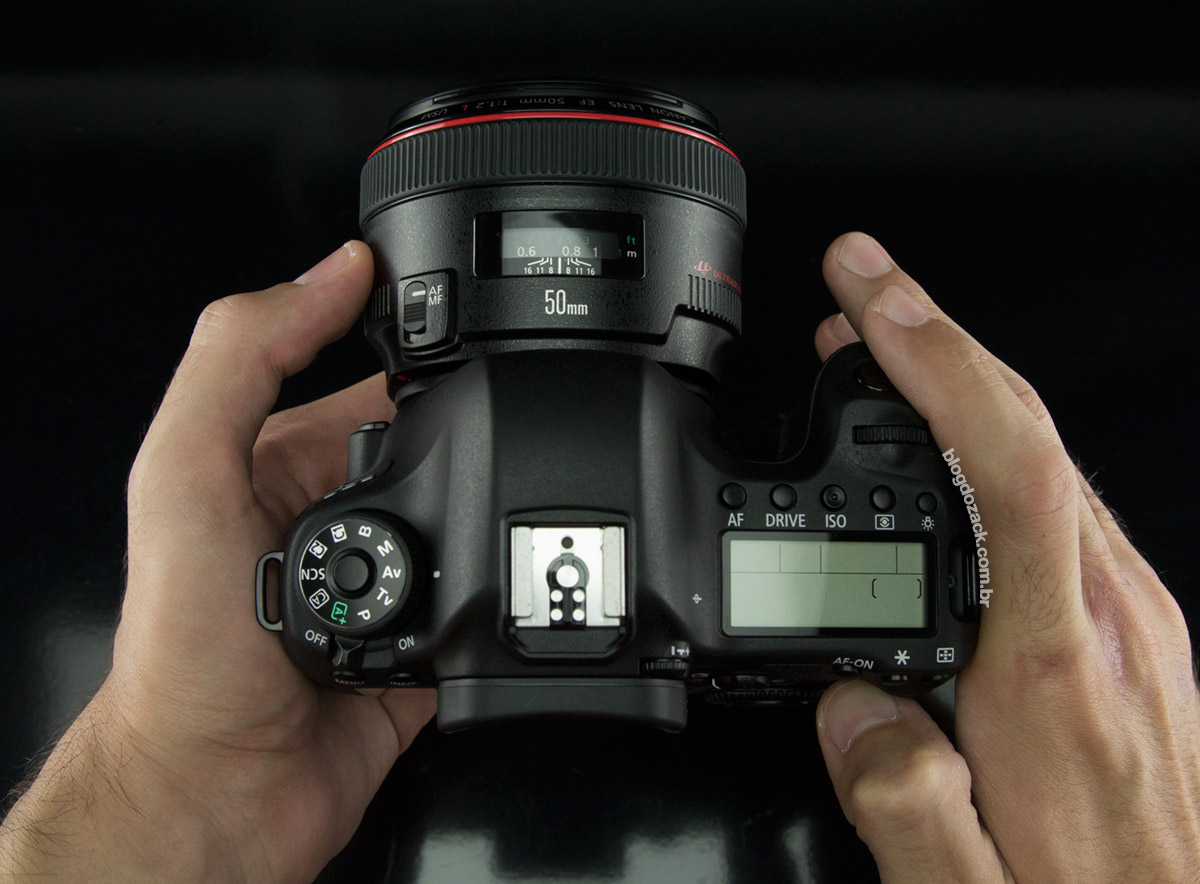
EOS 6D in hands: can you see any bone under stress?

A7II in hands: non existent grip and sharp edges. Notice the tension on my bones.
A SLR boots instantly at the turn of the rocker, and can be left ON all day long in the studio. The A7II can’t and takes forever to boot. It takes at least two seconds that the EOS 6D already boot and took five pictures. It’s the same story when I went from the F717 to the EOS 20D in 2004: the EOS “screams” shooting photo after photo, while the Sony “thinks” before it’s ready to shoot. And I won’t go back for Live View, EVF and camera design style. Thanks, but no thanks!

Sony F717 and EOS 20D: I won’t go 12 years back: battery, AF, questionable AF…
And don’t even get me started on the AF performance. Even if you do get over its ergonomics, the AF is just lagging. The Sony A6000 and Nikon 1 V3 promise awesome AF speed, with bloated numbers from the marketing department. But please, point a SLR with a top of the line zoom lens at the recently married couple to see if the camera won’t lock focus before their first kiss… Point a SLR to a soccer player before the last kick and it will lock focus before the touches the ball. I can guarantee a mirrorless camera won’t do that.

“Surf” with the EOS 5D Mark II + EF 100-400mm f/4.5-5.6L IS USM at f/8 1/2500 ISO200 @ 400mm; imagine the A7II Lock-On getting all lost…
And finally we’re down to lens selection. The E-Mount is too new for full frame lenses, and native options are scarce. There’s no f/2.8 14-24mm, 24-70mm and 70-200mm yet, the standard for most professionals. And forget about adapting CanoNikon lenses, the AF just won’t work fast enough. Buy an EOS instead! A SLR is larger and healthier not because it needs to be, but because it wants to. It’s no “skinny bitch” that will be a pain in the ass during a whole afternoon of photography.

If it wasn’t for the 390482093482 Canon lenses, vlog do zack wouldn’t even exists…
Who’s the A7II for? Will I keep it on my kit? In my opinion the A7II is a bigger treat to Leica’s market than Canon or Nikon, as the full frame mirrorless camera with interchangeable lens feels more like the M mount than the F ou EF system. It’s made for the cutting edge photographer that must justify it’s purchase on technology and features. It works as a camera above all, besides the steep learning curve in video mode. It’s too many functions, too many MENUS, new stuff even for me.

For video shooters coming from a DSLR it’s a very complete package. It’s small and light, and the file quality is exceptional for the price. The 1080P60 is always nice to have and the S-Log2 on a full frame, stabilised sensor is unheard off. It’s a no brainer for those shooting with 1080p Canon DSLRs.

But for the professional photo market, I would carefully think about it. It’s too many compromises, unreliable on the field, chaotic battery management, slow to boot and with short lens selection. It seems easy once it’s done: a DSLR will boot instantly, be in focus instantly, and deliver the files we need. Sony is on the right way, but there’s a good chance the A7II won’t be ready when you need it to. For landscape photography and some studio work, maybe. But that is it, photo wise.

And on vlog do zack the A7II just won’t find it’s place, no matter how awesome it is. It’s too much compromise just for Sony’s excellent Exmor sensors. I used to have Sony cameras and I left Sony behind. Every time I grab a EOS 6D I’m remembered of its leap in ergonomics, and I can’t stand a skinny bitch like the A7II with me all day. I just can’t. Nice shooting!
